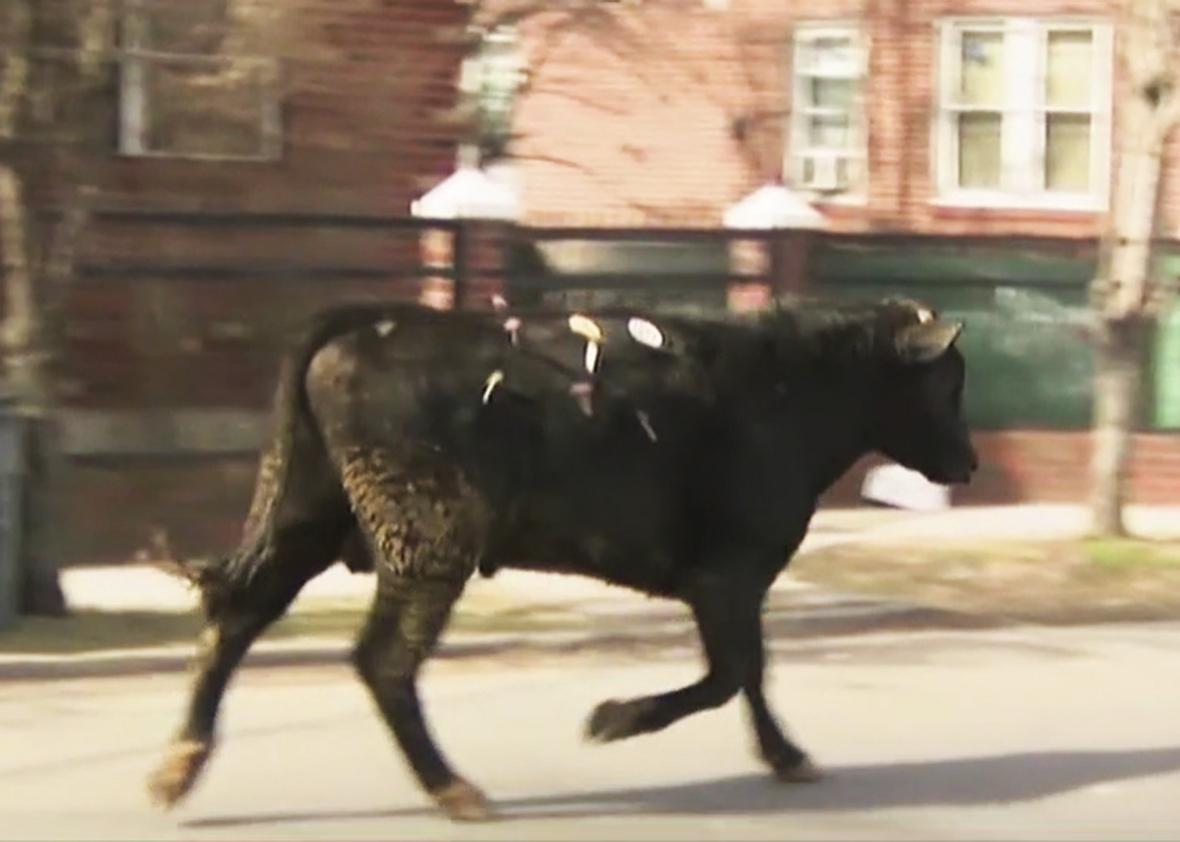Late Tuesday morning, a bull escaped a Queens slaughterhouse, causing an inadvertent “running of the bulls” moment for bystanders, police, and journalists alike. As the bull barreled along an unpredictable path, cops shot it with tranquilizers as they attempted to stop it. After a nearly three-hour-long chase during which no injuries were reported, the bull was eventually captured. Plans to send it to an animal sanctuary were made in vain—the bull died that afternoon while in transport. The cause of death has yet to be determined (it could be the dozen tranquilizers that actually hit the bull, it could be stress, etc.).
Of course, the internet has already started to mourn the bull, which it inevitably rooted for.
“We are all the Queens Cow,” one tweet proclaimed. “Just let him live his life!!” read another. The tweet from Eyewitness News in New York: “Rest in peace, Queens Bull. We hope you’re running wild and free in heaven’s pastures!”
The Queens cow never ran completely free in any pastures, and its entire existence was predicated on the fact that it would one day become a burger. Still, it’s natural that a large mammal on the loose in a metropolitan area would become a news story—but the most remarkable thing about the Queens bull is that it is not unique. It’s not even the first to escape in Jamaica, the neighborhood in Queens where it got loose. The last one, which escaped in April, gained perhaps even more fame after being rescued by the comedian Jon Stewart, who took the captured bull to a shelter in upstate New York. The previous month, another cow in Queens made an escape from a slaughterhouse, and it, too, was sent to a sanctuary. There was a Queens cow on the loose in 2011, and before that in 2009.
These high-profile escapes raise the inevitable question: What are livestock doing in Queens, anyway? It turns out that slaughterhouses in cities are on the rise. According to a New York Times article from 2009:
There are about 90 live-poultry markets in the [New York City] metropolitan area. That number has doubled since the mid-1990s, state officials say, because of the demands of immigrants from countries where eyeballing your meat while it is alive is considered common sense. About a quarter of the markets are also licensed to slaughter larger livestock.
In many instances, the livestock itself is only shipped in for slaughter, rather than being raised here (real estate in the city is still pricey). And the Big Apple seems to be the mecca of in-city slaughter, the Times article says:
New York has probably the country’s highest concentration of live-animal markets, though there are pockets in New Jersey, New England, Philadelphia, California and the Midwest, said Susan Trock, a veterinarian who manages poultry health inspections for the State Department of Agriculture and Markets.
Tom Mylan, who carves up cows in front of customers at Marlow & Daughters, a butcher shop and locavore’s temple in Williamsburg, Brooklyn, said he lived near three live-animal markets, two run by Hasidic Jews and one by Latin Americans. Although they may not share his obsession with animal welfare and organic feed, he said, he views them as allies against the mass-market industry he calls “big meat.”
New York seems to be an epicenter of demand thanks to the concentration of locavores, immigrants, religious observers, and foodies alike. But still, most cities’ meatpacking districts have now moved on to serve other needs—think of Chicago’s Union Stock Yards, which made the city at one point the meatpacking center of the world, or NYC’s own meatpacking district in western Manhattan, now the home of trendy clubs and the fictitious Samantha Jones. As slaughterhouses primarily moved to rural areas, many people have come to think of the idea of urban livestock as unnatural, even as they follow the tales of escaped animals with great interest. An escaped bull—and one fleeing from sudden death—is a sympathetic character, and we have a tendency to anthropomorphize animals that find themselves wandering city streets. But cattle, much like deer, are not in need of protection as a species.
It’s odd to bring large animals into population-dense areas to kill them—as the Queens bull shows, they can get loose and cause a lot more damage in a city than they might elsewhere. But what is possibly more unnatural is our tendency to separate the food we eat from the live animals that provide it. The motivations that are bringing slaughter back into the city are at the very least grounding—even if it does cause the occasional traffic jam.
